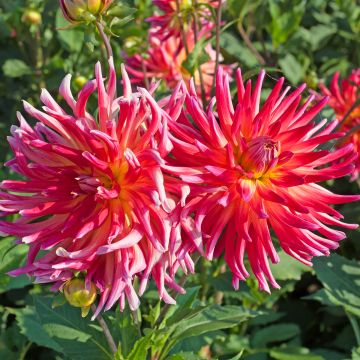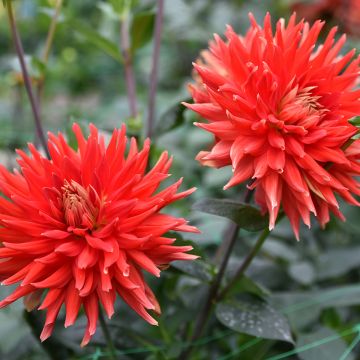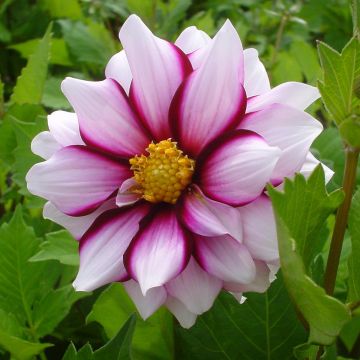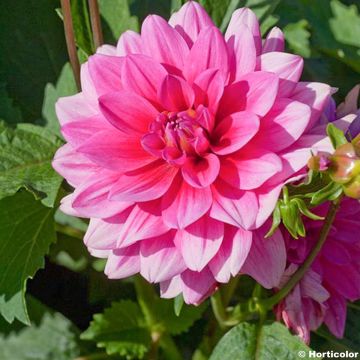

Dahlia Ice Crystal


Dahlia Ice Crystal


Dahlia Ice Crystal
Dahlia Ice Crystal
Dahlia Ice Crystal
Dahlia
This item cannot be shipped to the selected country
Delivery charge from €5.90
More information
Schedule delivery date,
and select date in basket
This plant carries a 6 months recovery warranty
More information
We guarantee the quality of our plants for a full growing cycle, and will replace at our expense any plant that fails to recover under normal climatic and planting conditions.
From €5.90 for pickup delivery and €6.90 for home delivery
Express home delivery from €8.90.

Does this plant fit my garden?
Set up your Plantfit profile →
Description
The 'Ice Crystal' Dahlia is a relatively tall summer bulb, about 1 m (3ft) in height. The large 15 cm (6in) flowers are typical of cactus dahlias and have long, very slender white petals. The centre is delicately marked with pale yellow, giving it a great refinement. Dahlias are spectacular bulbs that offer an explosion of flowers throughout the summer and are also perfect for bouquets. They are not very hardy and should be planted in late spring or early summer in a rather rich and well-drained soil, and stored away for winter.
The 'Ice Crystal' Cactus Dahlia belongs to the Asteraceae family, which is rich in well-known ornamental plants such as asters, rudbeckias, sunflowers, Dahlias, named after the Swedish botanist Andreas Dahl, are fast-growing tuberous perennials. Discovered in the late 16th century in the high plateaus of Mexico, they were not introduced to Europe until 100 years later. Initially tested for their food potential due to their large fleshy tubers, they quickly became highly sought-after ornamental plants, and breeders soon created countless varieties (there are now 20 to 25,000 known varieties!) with distinct characteristics. The large 3 or 5-lobed leaves are medium to dark green, and flowering extends from July to October.
The 'Ice Crystal' variety belongs to the Cactus dahlias group, which is characterized by large, very slender "petals" that curve inwards along their length. Pure white in color, their base is lightly marked with pale yellow, adding a lot of grace to the 15 cm (6in) diameter flower. The plant forms a dense and bushy shrub that reaches an average height of 1 meter (3 feet).
Plant the 'Ice Crystal' Dahlia in the ground in mid to late spring when frost is no longer a concern. Dahlias prefer a cool and rather rich, well-drained soil. You can take advantage of planting to divide the plant by removing one or more tubers if they have at least one well-developed eye. Staking is recommended, especially if your garden is exposed to wind. Then, simply remove faded flowers as they appear. The robust and hollow stems are also suitable for making bouquets. As soon as the cold returns, it is advisable to dig up the tubers and store them in a dark and dry place such as a garage. The plant is destroyed at temperatures below -6°C (21.2°F) and can only be left in the garden all year round in the mildest regions.
Combine the 'Ice Crystal' Dahlia with other varieties such as 'Tartan' or 'Thomas Edison'. It will also liven up late summer flowerbeds, amidst other later-flowering perennials such as 'Tradescant' Divaricate Aster, Vernonia crinita, or 'Gracillimus' Miscanthus sinensis with its long, slender leaves that will contrast with the coarser foliage of the dahlia.
Report an error about the product description
Plant habit
Flowering
Foliage
Botanical data
Dahlia
Ice Crystal
Asteraceae
Dahlia
Cultivar or hybrid
Other Cactus Dahlia
Planting and care
Plant your dahlias during the warm days in deeply cultivated soil enriched, for example, with crushed horn or dehydrated blood. Place your tubercle and crumble the soil well to fill in without any air pockets. Your dahlia should be covered with 6 cm (2in) of soil. At the end of the planting, pour a litre of water. Water regularly during the first 6 weeks to help with rooting. Dahlias are sensitive to cold. They need to be overwintered. In November, the first frosts will darken the foliage, which is the time to dig them up. Carefully unearth the tubercles. Remove as much soil as possible. Let the foliage dry so that the tubercle can replenish its reserves. When the foliage is dry, cut the stems 10 cm (4in) from the tubercle. Spread your bulbs in a crate on newspaper. Store away from frost in a dry, cool, and dark place.
Planting period
Intended location
Care
This item has not been reviewed yet - be the first to leave a review about it.
Dahlias
Haven't found what you were looking for?
Hardiness is the lowest winter temperature a plant can endure without suffering serious damage or even dying. However, hardiness is affected by location (a sheltered area, such as a patio), protection (winter cover) and soil type (hardiness is improved by well-drained soil).

Photo Sharing Terms & Conditions
In order to encourage gardeners to interact and share their experiences, Promesse de fleurs offers various media enabling content to be uploaded onto its Site - in particular via the ‘Photo sharing’ module.
The User agrees to refrain from:
- Posting any content that is illegal, prejudicial, insulting, racist, inciteful to hatred, revisionist, contrary to public decency, that infringes on privacy or on the privacy rights of third parties, in particular the publicity rights of persons and goods, intellectual property rights, or the right to privacy.
- Submitting content on behalf of a third party;
- Impersonate the identity of a third party and/or publish any personal information about a third party;
In general, the User undertakes to refrain from any unethical behaviour.
All Content (in particular text, comments, files, images, photos, videos, creative works, etc.), which may be subject to property or intellectual property rights, image or other private rights, shall remain the property of the User, subject to the limited rights granted by the terms of the licence granted by Promesse de fleurs as stated below. Users are at liberty to publish or not to publish such Content on the Site, notably via the ‘Photo Sharing’ facility, and accept that this Content shall be made public and freely accessible, notably on the Internet.
Users further acknowledge, undertake to have ,and guarantee that they hold all necessary rights and permissions to publish such material on the Site, in particular with regard to the legislation in force pertaining to any privacy, property, intellectual property, image, or contractual rights, or rights of any other nature. By publishing such Content on the Site, Users acknowledge accepting full liability as publishers of the Content within the meaning of the law, and grant Promesse de fleurs, free of charge, an inclusive, worldwide licence for the said Content for the entire duration of its publication, including all reproduction, representation, up/downloading, displaying, performing, transmission, and storage rights.
Users also grant permission for their name to be linked to the Content and accept that this link may not always be made available.
By engaging in posting material, Users consent to their Content becoming automatically accessible on the Internet, in particular on other sites and/or blogs and/or web pages of the Promesse de fleurs site, including in particular social pages and the Promesse de fleurs catalogue.
Users may secure the removal of entrusted content free of charge by issuing a simple request via our contact form.
The flowering period indicated on our website applies to countries and regions located in USDA zone 8 (France, the United Kingdom, Ireland, the Netherlands, etc.)
It will vary according to where you live:
- In zones 9 to 10 (Italy, Spain, Greece, etc.), flowering will occur about 2 to 4 weeks earlier.
- In zones 6 to 7 (Germany, Poland, Slovenia, and lower mountainous regions), flowering will be delayed by 2 to 3 weeks.
- In zone 5 (Central Europe, Scandinavia), blooming will be delayed by 3 to 5 weeks.
In temperate climates, pruning of spring-flowering shrubs (forsythia, spireas, etc.) should be done just after flowering.
Pruning of summer-flowering shrubs (Indian Lilac, Perovskia, etc.) can be done in winter or spring.
In cold regions as well as with frost-sensitive plants, avoid pruning too early when severe frosts may still occur.
The planting period indicated on our website applies to countries and regions located in USDA zone 8 (France, United Kingdom, Ireland, Netherlands).
It will vary according to where you live:
- In Mediterranean zones (Marseille, Madrid, Milan, etc.), autumn and winter are the best planting periods.
- In continental zones (Strasbourg, Munich, Vienna, etc.), delay planting by 2 to 3 weeks in spring and bring it forward by 2 to 4 weeks in autumn.
- In mountainous regions (the Alps, Pyrenees, Carpathians, etc.), it is best to plant in late spring (May-June) or late summer (August-September).
The harvesting period indicated on our website applies to countries and regions in USDA zone 8 (France, England, Ireland, the Netherlands).
In colder areas (Scandinavia, Poland, Austria...) fruit and vegetable harvests are likely to be delayed by 3-4 weeks.
In warmer areas (Italy, Spain, Greece, etc.), harvesting will probably take place earlier, depending on weather conditions.
The sowing periods indicated on our website apply to countries and regions within USDA Zone 8 (France, UK, Ireland, Netherlands).
In colder areas (Scandinavia, Poland, Austria...), delay any outdoor sowing by 3-4 weeks, or sow under glass.
In warmer climes (Italy, Spain, Greece, etc.), bring outdoor sowing forward by a few weeks.























































